In the world of digital music, audio quality is a topic of continuous discussion and debate. One commonly encountered term when it comes to audio quality is “256kbps,” which refers to the bit rate of a digital audio file. But is 256kbps audio considered good quality? In this article, we’ll explore the factors that influence audio quality and whether a bit rate of 256kbps is sufficient for most listeners.
Understanding Bit Rate
Bit rate is a measure of how much data is transmitted per unit of time and is usually expressed in kilobits per second (kbps) for audio files. Higher bit rates generally mean better audio quality, as more data can be used to represent the original sound. However, the actual perceived quality depends on several factors.
Factors Influencing Audio Quality
- Source Material: The quality of the original recording is a fundamental factor in determining audio quality. A poorly recorded or mastered track may not benefit significantly from a higher bit rate.
- Compression Algorithm: The codec used to compress the audio has a profound effect on quality. Lossy codecs, like MP3 and AAC, discard some audio data to reduce file size. Lossless codecs, such as FLAC and ALAC, preserve all the original data, providing higher quality but larger file sizes.
- Listener’s Preferences: What is considered “good quality” varies from person to person. Some listeners have finely tuned ears and can discern subtle differences, while others may not notice significant variations in audio quality.
256kbps Audio Quality
A bit rate of 256kbps is generally considered to be of good quality, particularly for most casual listeners and everyday listening scenarios. Here are some key points to consider:
- Compression Efficiency: At 256kbps, lossy codecs like MP3 and AAC can provide a good balance between audio quality and file size. This bit rate is often used for streaming services, allowing for efficient data transmission and quick downloads.
- Transparency: Many listeners may not be able to distinguish between a high-quality source and a 256kbps compressed file, especially when listening through standard headphones or speakers. For most popular music genres, 256kbps audio is perceived as “transparent,” meaning that the loss in quality is minimal and not easily noticeable.
- Storage and Bandwidth: 256kbps files are relatively small, making them practical for storage and streaming. This bit rate strikes a balance between conserving storage space and delivering enjoyable audio quality.
- Context Matters: The context in which you’re listening also plays a role. In a quiet room with high-end equipment, you might notice a difference between 256kbps and higher bit rates. However, in noisy environments or while using modest audio equipment, the distinction may not be as pronounced.
Whether 256kbps audio is considered good quality largely depends on your individual preferences, your listening environment, and the quality of your audio equipment. While it may not meet the standards of audiophiles or studio professionals who demand the utmost in audio fidelity, for most everyday listening purposes, 256kbps audio provides a satisfying listening experience.
Ultimately, the definition of “good quality” in audio is subjective and context-dependent. If you’re concerned about audio quality, you can experiment with higher bit rates or lossless formats, but you’ll need to balance this with considerations related to storage, bandwidth, and the capabilities of your playback devices. In many cases, 256kbps audio is more than adequate for enjoying your favorite music without compromising on quality.


